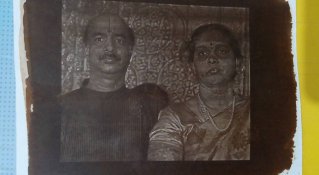Krishnan Srinivasan
Member
Hi ,
Attached a sample image (taken from mobile cam):
I'm a first timer and very new to salt/contact printing. I couldn't afford much , so trying it in a home setup.Did some research online and prepared my solutions. Finally settled for 2% Sodium chloride Sea Crystal Salt and 18.6g of Silver Nitrate in 140ml Distilled water. I tried sunlight , results were bad. I used my basic strobes which has 100W bulb , I have two of them. It gives me decent results. There is no Pictorico films available in India. Even if it is made available I might have to pay dollar value which is 68 times the cost , beyond reach to say. So I found peace with OHP polyester sheets.Paper Negatives didn't work for me. These are my unfortunate / fortunate situation.I get a dark/Brown color with the results for 1.5HR exposure.
I used Sodium Thiosulfate 50g , Sodium carbonate 10g , Sodium sulfite 5g per 1000ml solution for fixer.
10g Sodium sulfite per 1000ml as clearing agent.
15g of Potassium Ferrocynade & 15g of Pottassium Bromade per 1000ml as Sepia toning.
15g of Selenate anhydrous per 1000ml for Selenium toning.
It's a test paper that I obtained from local store ,since I don't get any branded stuff .
I got a wet on wet Canson Montval 300gsm paper A3 , saved it for good prints .
Kindly help me with few things :
What could be the proper mixture of silver nitrate ? I might have to finish the existing solution to proceed further.
I used Cooking Sea salt crystals because the Agar Agar veg gelatin didn't work .! Is there any good substitutes ?
Attached a sample image (taken from mobile cam):
I'm a first timer and very new to salt/contact printing. I couldn't afford much , so trying it in a home setup.Did some research online and prepared my solutions. Finally settled for 2% Sodium chloride Sea Crystal Salt and 18.6g of Silver Nitrate in 140ml Distilled water. I tried sunlight , results were bad. I used my basic strobes which has 100W bulb , I have two of them. It gives me decent results. There is no Pictorico films available in India. Even if it is made available I might have to pay dollar value which is 68 times the cost , beyond reach to say. So I found peace with OHP polyester sheets.Paper Negatives didn't work for me. These are my unfortunate / fortunate situation.I get a dark/Brown color with the results for 1.5HR exposure.
I used Sodium Thiosulfate 50g , Sodium carbonate 10g , Sodium sulfite 5g per 1000ml solution for fixer.
10g Sodium sulfite per 1000ml as clearing agent.
15g of Potassium Ferrocynade & 15g of Pottassium Bromade per 1000ml as Sepia toning.
15g of Selenate anhydrous per 1000ml for Selenium toning.
It's a test paper that I obtained from local store ,since I don't get any branded stuff .
I got a wet on wet Canson Montval 300gsm paper A3 , saved it for good prints .
Kindly help me with few things :
What could be the proper mixture of silver nitrate ? I might have to finish the existing solution to proceed further.
I used Cooking Sea salt crystals because the Agar Agar veg gelatin didn't work .! Is there any good substitutes ?
Attachments
Last edited:








